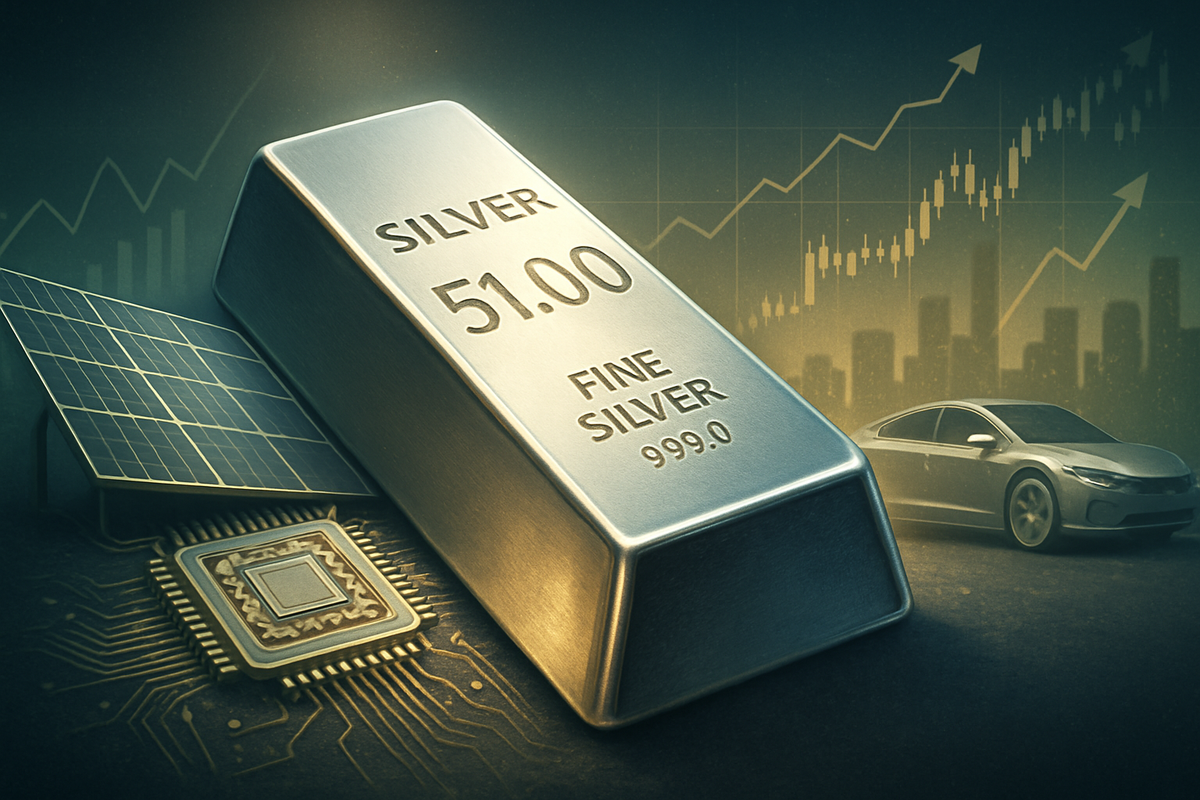
Silver has shattered historical ceilings, surging past the $50 per troy ounce mark and reaching an unprecedented $51.10 on October 9, 2025. This historic rally, representing a staggering 73.1% gain since January 2025, marks a pivotal moment for the precious metals market, cementing silver's dual role as both a critical industrial commodity and a coveted safe-haven asset. The immediate implications are profound, signaling a potential paradigm shift in investment strategies and industrial supply chains globally.
This monumental surge underscores a tightening physical market driven by relentless demand from burgeoning green energy sectors and a persistent structural supply deficit. The psychological barrier of $50, a level last briefly touched in 1980 and 2011, has been decisively breached, drawing significant attention from investors, industries, and policymakers alike. As the market grapples with this new valuation, the ripple effects are expected to reverberate across various sectors, from mining and manufacturing to finance and consumer goods.
The Unprecedented Rally: Details of Silver's Historic Surge
Silver's journey to over $51 per troy ounce on October 9, 2025, is a narrative of converging forces, culminating in a price point that has rewritten its modern history. Starting the year near $29 per ounce, silver has delivered an astounding year-to-date return, with the most dramatic gains observed in the third quarter. On October 8, silver closed at an all-time high of $48.74, only to make history the following day by breaching the $50 threshold in intraday trading, soaring past $50.36 and even touching $51.10 per ounce.
This rally is fundamentally different from its predecessors. The 1980 spike, which saw silver briefly hit $50.36, was largely attributed to the speculative attempts by the Hunt Brothers to corner the market, ending in a dramatic crash. The 2011 rally, reaching nearly $49, was fueled by post-financial crisis quantitative easing and inflation fears. The current ascent, however, is underpinned by a robust confluence of factors: accelerating industrial demand from green energy (solar panels, electric vehicles), persistent global supply deficits (projected at 187.6 million ounces in 2025), and heightened safe-haven investment amid global economic uncertainties and geopolitical tensions. Key stakeholders include major silver mining companies, industrial consumers, and a growing cohort of institutional and retail investors seeking refuge in tangible assets. Initial market reactions are a mix of bullish optimism, with many analysts calling this a "legitimate and sustainable bull market," and cautious observation of potential volatility around this significant price level.
Winners and Losers: Corporate Impact of the Silver Surge
Silver's historic surge to $51 per troy ounce creates a clear delineation between beneficiaries and those facing significant headwinds across the corporate landscape.
Potential Winners: Silver mining companies are the most direct beneficiaries. Companies like Pan American Silver Corp. (NASDAQ: PAAS), First Majestic Silver Corp. (NYSE: AG), and Hecla Mining Company (NYSE: HL) will see direct boosts to their revenues and profit margins, enabling greater investment in exploration and operational expansion. Precious metals streaming companies such as Wheaton Precious Metals Corp. (NYSE: WPM), which acquire future production at fixed prices, will also see the value of their assets appreciate significantly. Furthermore, silver-backed Exchange-Traded Funds (ETFs) like iShares Silver Trust (NYSE Arca: SLV) and Sprott Physical Silver Trust (NYSE Arca: PSLV), as well as silver miners' ETFs like Global X Silver Miners ETF (NYSE Arca: SIL), are experiencing substantial inflows and appreciation. Refiners and dealers of precious metals are also poised for increased activity due to heightened demand.
Potential Losers (or those facing significant challenges): Industries heavily reliant on silver as a critical input material will face escalating production costs. Solar panel manufacturers, including major players like First Solar (NASDAQ: FSLR) and JinkoSolar (NYSE: JKS), are particularly vulnerable, as silver is indispensable for conductive pastes in solar cells. Similarly, electronics and electrical manufacturers such as Apple Inc. (NASDAQ: AAPL), Samsung Electronics Co., Ltd. (KRX: 005930), and Intel Corporation (NASDAQ: INTC), which use silver in circuit boards, connectors, and advanced chips, will contend with higher material costs. The burgeoning electric vehicle (EV) sector, including companies like Tesla, Inc. (NASDAQ: TSLA), also uses substantial amounts of silver in electrical systems, battery management, and charging infrastructure, leading to increased manufacturing expenses. Finally, jewelry manufacturers and retailers may experience a decline in sales as higher silver prices translate directly into increased consumer costs, impacting demand for silver-based products. These industries may need to absorb costs, pass them on to consumers, or accelerate research into silver-thrifting technologies and alternative materials.
A Broader Perspective: Wider Significance and Historical Context
The surge in silver to over $51 per troy ounce on October 9, 2025, holds profound wider significance, signaling a structural shift within the commodities market and reflecting deeper macroeconomic trends. This event fits squarely into the broader narrative of the green energy revolution, where silver is indispensable for solar panels, electric vehicles, and 5G infrastructure. Industrial demand, projected to consume 59% of total silver usage in 2025, is no longer a peripheral factor but a primary driver, setting this rally apart from past speculative surges.
The ripple effects are far-reaching. Beyond the immediate impact on mining and consuming industries, the elevated price of silver will put pressure on supply chain resilience globally. Governments and industries may increasingly view silver not just as a precious metal but as a strategic industrial resource, potentially leading to policy discussions around strategic reserves, incentivizing domestic mining, and accelerating research into material substitution. Historically, silver has often been considered "poor man's gold," but its industrial utility is now elevating its status. While the 1980 spike was a speculative bubble orchestrated by the Hunt Brothers, and the 2011 rally was largely a response to monetary easing, the current surge is characterized by fundamental supply-demand imbalances coupled with persistent inflation fears and geopolitical instability. The gold-to-silver ratio is also a key indicator to watch; a narrowing ratio suggests silver is outperforming gold, a common characteristic of robust precious metals bull markets. This re-evaluation of silver's value could have lasting implications for how it is perceived and integrated into global economic strategies.
The Road Ahead: What Comes Next for Silver
Following its historic breach of the $50 mark, silver is poised for a dynamic period, presenting both opportunities and challenges for investors and industries.
In the short-term, the market is likely to experience continued volatility as silver navigates this new price discovery phase. While some profit-taking may lead to temporary pullbacks, the strong underlying fundamentals suggest a sustained bullish trend. Analysts anticipate silver will test new resistance levels, potentially consolidating in the $50-$55 range before further upward movement. Increased investor attention could also lead to a "silver squeeze," where demand for physical metal overwhelms available supply, causing sharp, albeit potentially temporary, price spikes. Industrial users, facing higher input costs, will need to make immediate strategic pivots, potentially prioritizing critical applications or accelerating "thrifting" efforts to reduce silver content.
The long-term outlook appears largely bullish. Many analysts project silver to continue its ascent, with forecasts reaching $60 by the end of 2025 and even $80 by the end of 2026. Some ambitious predictions see silver potentially reaching $100 or even $250 per ounce in the coming years, citing inflation-adjusted historical highs that suggest significant theoretical upside. The relentless growth of green energy technologies—solar, EVs, 5G—will ensure sustained industrial demand, while persistent supply deficits due to declining ore grades and underinvestment in mining will likely keep the market tight. Mining companies will be incentivized to increase exploration and development, though these projects have long lead times. Investors will need to consider portfolio rebalancing and diversification, potentially including silver mining equities for leveraged exposure, while industrial users must focus on supply chain resilience and innovation in silver-efficient designs.
Concluding Thoughts: A New Era for the White Metal
Silver's historic surge past $51 per troy ounce on October 9, 2025, marks a definitive turning point for the "white metal." The key takeaway is the robust and multifaceted nature of this rally, driven equally by insatiable industrial demand from the green energy transition and unwavering investment interest amidst global economic uncertainty. This is not merely a speculative bubble but a re-rating of silver's intrinsic value, recognizing its indispensable role in the modern world.
Moving forward, the market is likely to remain dynamic, with a strong bullish bias underpinned by structural supply deficits and continuous demand from critical technologies. The lasting impact of this event could be a fundamental shift in how silver is perceived—from a secondary precious metal to a strategic industrial commodity vital for global decarbonization and technological advancement. This re-evaluation could lead to a sustained period of higher prices, redefining its position in both investment portfolios and industrial supply chains.
Investors should closely monitor central bank monetary policies, global industrial growth trends (especially in solar and EVs), and ongoing supply dynamics. The gold-to-silver ratio will continue to be a crucial indicator for relative value. While silver's inherent volatility demands caution and effective risk management, the current environment suggests that the forces driving its ascent are powerful and enduring, making it an asset to watch closely in the coming months and years.
This content is intended for informational purposes only and is not financial advice






